Page 84 of 304
84 Controls in detailLightingFor nighttime driving you should turn the
exterior lamp switch to position
B
to
permit activation of the high beam head-
lamps.
Switching on front fog lamps
�
Check that the low beam headlamps
are switched on.
�
Pull out exterior lamp switch to first
stop.
The green indicator lamp
‡
in the
lamp switch lights up.Switching on rear fog lamp
�
Check that the low beam headlamps
are switched on.
�
Pull out exterior lamp switch to second
stop.
The yellow indicator lamp
†
in the
lamp switch lights up.
Combination switch
The combination switch is located on the
left side of the steering column.
1High beam
2High beam flasher
iThe high beam flasher is always avail-
able.
iFog lamps will operate with the parking
lamps and/or low beam headlamps on.
Fog lamps should only be used in con-
junction with low beam headlamps.
Consult your State or Province Motor
Vehicle Regulations regarding allow-
able lamp operation.
Page 99 of 304
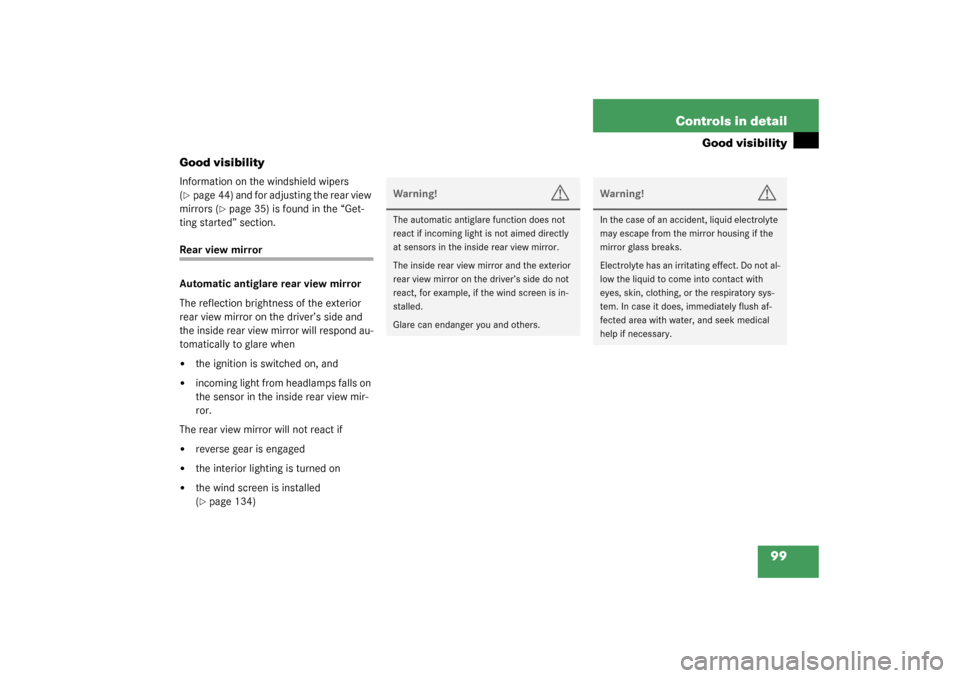
99 Controls in detail
Good visibility
Good visibility
Information on the windshield wipers
(�page 44) and for adjusting the rear view
mirrors (
�page 35) is found in the “Get-
ting started” section.
Rear view mirror
Automatic antiglare rear view mirror
The reflection brightness of the exterior
rear view mirror on the driver’s side and
the inside rear view mirror will respond au-
tomatically to glare when�
the ignition is switched on, and
�
incoming light from headlamps falls on
the sensor in the inside rear view mir-
ror.
The rear view mirror will not react if
�
reverse gear is engaged
�
the interior lighting is turned on
�
the wind screen is installed
(�page 134)
Warning!
G
The automatic antiglare function does not
react if incoming light is not aimed directly
at sensors in the inside rear view mirror.
The inside rear view mirror and the exterior
rear view mirror on the driver’s side do not
react, for example, if the wind screen is in-
stalled.
Glare can endanger you and others.
Warning!
G
In the case of an accident, liquid electrolyte
may escape from the mirror housing if the
mirror glass breaks.
Electrolyte has an irritating effect. Do not al-
low the liquid to come into contact with
eyes, skin, clothing, or the respiratory sys-
tem. In case it does, immediately flush af-
fected area with water, and seek medical
help if necessary.
Page 100 of 304
100 Controls in detailGood visibility
Headlamp cleaning system*
The switch is located on the center con-
sole.
1Headlamp washer switch�
Switch on ignition.
�
Briefly press upper part of switch1.
Warning!
G
Exercise care when using the passenger
side exterior rear view mirror. The mirror
surface is convex (outwardly curved surface
for a wider field of view). Objects in mirror
are closer than they appear. Check your in-
side rear view mirror or glance over your
shoulder before changing lanes.!Electrolyte drops coming into contact
with the vehicle paint finish can be
completely removed only while in the
liquid state by applying plenty of water.
Page 170 of 304
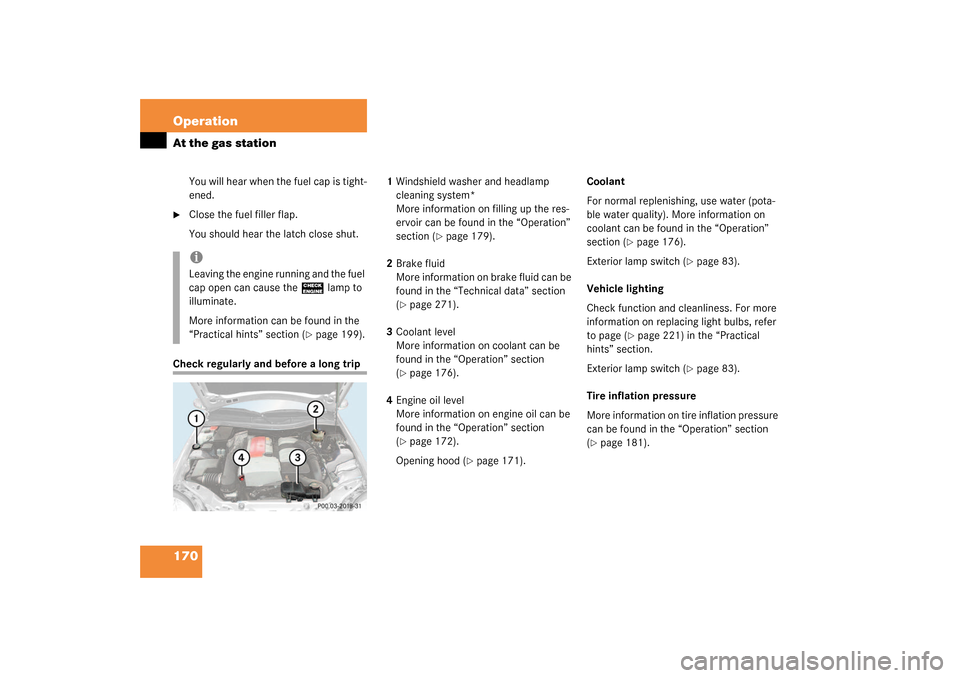
170 OperationAt the gas station
You will hear when the fuel cap is tight-
ened.
�
Close the fuel filler flap.
You should hear the latch close shut.
Check regularly and before a long trip1Windshield washer and headlamp
cleaning system*
More information on filling up the res-
ervoir can be found in the “Operation”
section (
�page 179).
2Brake fluid
More information on brake fluid can be
found in the “Technical data” section
(
�page 271).
3Coolant level
More information on coolant can be
found in the “Operation” section
(�page 176).
4Engine oil level
More information on engine oil can be
found in the “Operation” section
(�page 172).
Opening hood (
�page 171).Coolant
For normal replenishing, use water (pota-
ble water quality). More information on
coolant can be found in the “Operation”
section (
�page 176).
Exterior lamp switch (
�page 83).
Vehicle lighting
Check function and cleanliness. For more
information on replacing light bulbs, refer
to page (
�page 221) in the “Practical
hints” section.
Exterior lamp switch (
�page 83).
Tire inflation pressure
More information on tire inflation pressure
can be found in the “Operation” section
(
�page 181).
iLeaving the engine running and the fuel
cap open can cause the
?
lamp to
illuminate.
More information can be found in the
“Practical hints” section (
�page 199).
Page 172 of 304
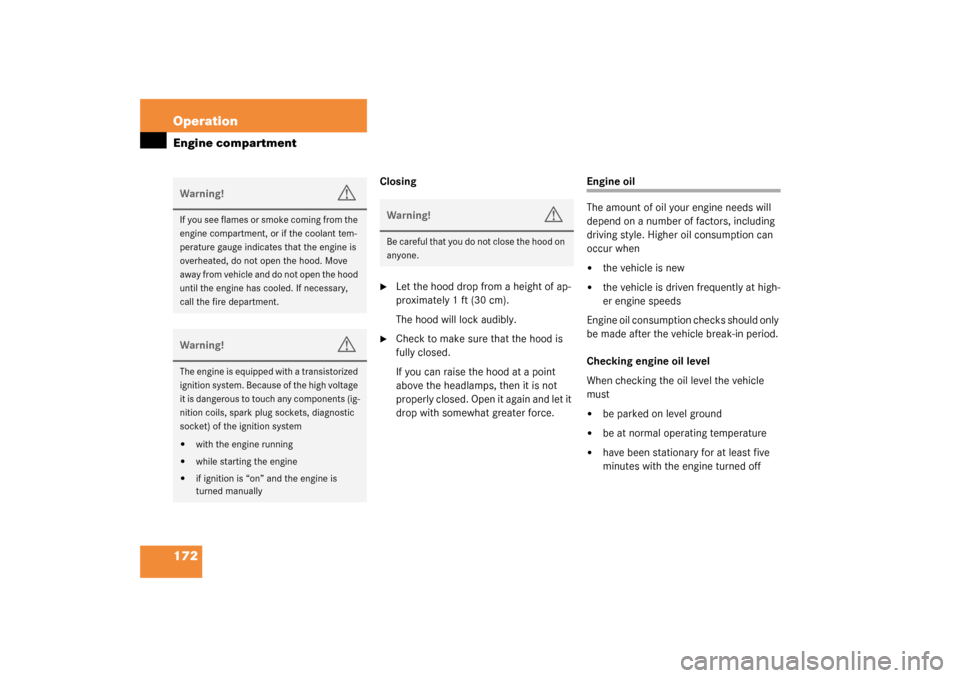
172 OperationEngine compartment
Closing�
Let the hood drop from a height of ap-
proximately 1ft (30cm).
The hood will lock audibly.
�
Check to make sure that the hood is
fully closed.
If you can raise the hood at a point
above the headlamps, then it is not
properly closed. Open it again and let it
drop with somewhat greater force.
Engine oil
The amount of oil your engine needs will
depend on a number of factors, including
driving style. Higher oil consumption can
occur when�
the vehicle is new
�
the vehicle is driven frequently at high-
er engine speeds
Engine oil consumption checks should only
be made after the vehicle break-in period.
Checking engine oil level
When checking the oil level the vehicle
must
�
be parked on level ground
�
be at normal operating temperature
�
have been stationary for at least five
minutes with the engine turned off
Warning!
G
If you see flames or smoke coming from the
engine compartment, or if the coolant tem-
perature gauge indicates that the engine is
overheated, do not open the hood. Move
away from vehicle and do not open the hood
until the engine has cooled. If necessary,
call the fire department.Warning!
G
The engine is equipped with a transistorized
ignition system. Because of the high voltage
it is dangerous to touch any components (ig-
nition coils, spark plug sockets, diagnostic
socket) of the ignition system�
with the engine running
�
while starting the engine
�
if ignition is “on” and the engine is
turned manually
Warning!
G
Be careful that you do not close the hood on
anyone.
Page 179 of 304
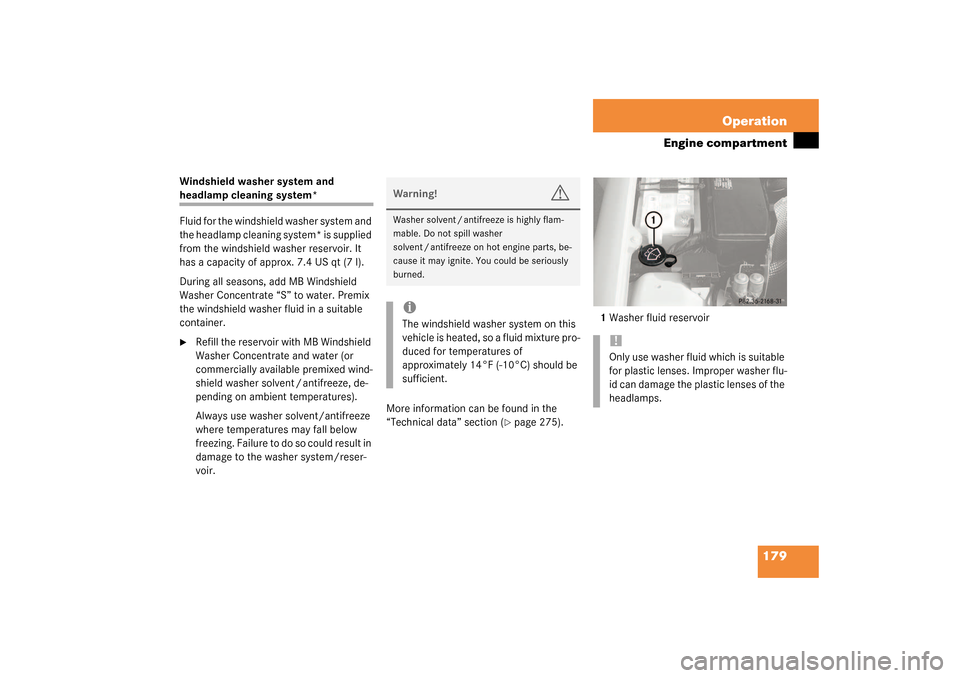
179 Operation
Engine compartment
Windshield washer system and headlamp cleaning system*
Fluid for the windshield washer system and
the headlamp cleaning system* is supplied
from the windshield washer reservoir. It
has a capacity of approx. 7.4 US qt (7 l).
During all seasons, add MB Windshield
Washer Concentrate “S” to water. Premix
the windshield washer fluid in a suitable
container.�
Refill the reservoir with MB Windshield
Washer Concentrate and water (or
commercially available premixed wind-
shield washer solvent / antifreeze, de-
pending on ambient temperatures).
Always use washer solvent/antifreeze
where temperatures may fall below
freezing. Failure to do so could result in
damage to the washer system/reser-
voir.More information can be found in the
“Technical data” section (
�page 275).1Washer fluid reservoir
Warning!
G
Washer solvent / antifreeze is highly flam-
mable. Do not spill washer
solvent / antifreeze on hot engine parts, be-
cause it may ignite. You could be seriously
burned.iThe windshield washer system on this
vehicle is heated, so a fluid mixture pro-
duced for temperatures of
approximately 14°F (-10°C) should be
sufficient.
!Only use washer fluid which is suitable
for plastic lenses. Improper washer flu-
id can damage the plastic lenses of the
headlamps.
Page 183 of 304
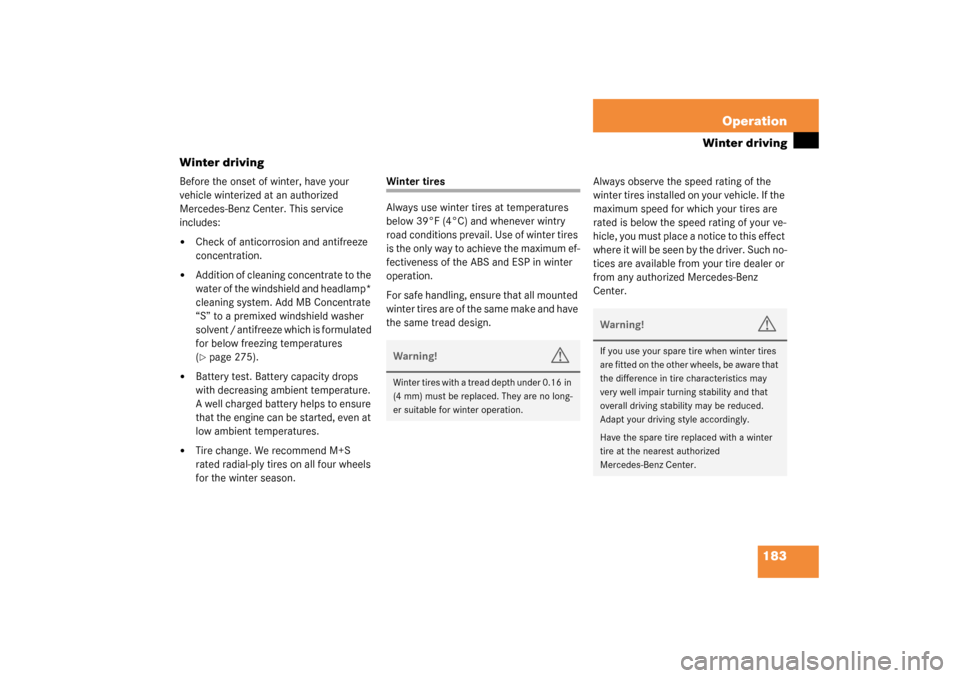
183 Operation
Winter driving
Winter driving
Before the onset of winter, have your
vehicle winterized at an authorized
Mercedes-Benz Center. This service
includes:�
Check of anticorrosion and antifreeze
concentration.
�
Addition of cleaning concentrate to the
water of the windshield and headlamp*
cleaning system. Add MB Concentrate
“S” to a premixed windshield washer
solvent / antifreeze which is formulated
for below freezing temperatures
(�page 275).
�
Battery test. Battery capacity drops
with decreasing ambient temperature.
A well charged battery helps to ensure
that the engine can be started, even at
low ambient temperatures.
�
Tire change. We recommend M+S
rated radial-ply tires on all four wheels
for the winter season.
Winter tires
Always use winter tires at temperatures
below 39°F (4°C) and whenever wintry
road conditions prevail. Use of winter tires
is the only way to achieve the maximum ef-
fectiveness of the ABS and ESP in winter
operation.
For safe handling, ensure that all mounted
winter tires are of the same make and have
the same tread design.Always observe the speed rating of the
winter tires installed on your vehicle. If the
maximum speed for which your tires are
rated is below the speed rating of your ve-
hicle, you must place a notice to this effect
where it will be seen by the driver. Such no-
tices are available from your tire dealer or
from any authorized Mercedes-Benz
Center.Warning!
G
Winter tires with a tread depth under 0.16 in
(4 mm) must be replaced. They are no long-
er suitable for winter operation.
Warning!
G
If you use your spare tire when winter tires
are fitted on the other wheels, be aware that
the difference in tire characteristics may
very well impair turning stability and that
overall driving stability may be reduced.
Adapt your driving style accordingly.
Have the spare tire replaced with a winter
tire at the nearest authorized
Mercedes-Benz Center.
Page 189 of 304
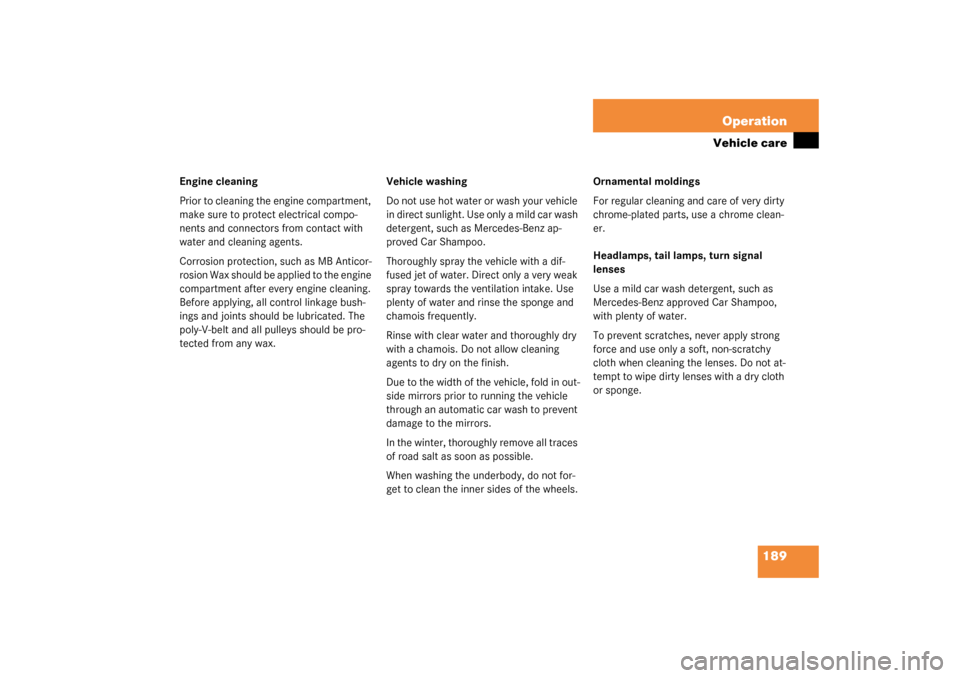
189 Operation
Vehicle care
Engine cleaning
Prior to cleaning the engine compartment,
make sure to protect electrical compo-
nents and connectors from contact with
water and cleaning agents.
Corrosion protection, such as MB Anticor-
rosion Wax should be applied to the engine
compartment after every engine cleaning.
Before applying, all control linkage bush-
ings and joints should be lubricated. The
poly-V-belt and all pulleys should be pro-
tected from any wax. Vehicle washing
Do not use hot water or wash your vehicle
in direct sunlight. Use only a mild car wash
detergent, such as Mercedes-Benz ap-
proved Car Shampoo.
Thoroughly spray the vehicle with a dif-
fused jet of water. Direct only a very weak
spray towards the ventilation intake. Use
plenty of water and rinse the sponge and
chamois frequently.
Rinse with clear water and thoroughly dry
with a chamois. Do not allow cleaning
agents to dry on the finish.
Due to the width of the vehicle, fold in out-
side mirrors prior to running the vehicle
through an automatic car wash to prevent
damage to the mirrors.
In the winter, thoroughly remove all traces
of road salt as soon as possible.
When washing the underbody, do not for-
get to clean the inner sides of the wheels.Ornamental moldings
For regular cleaning and care of very dirty
chrome-plated parts, use a chrome clean-
er.
Headlamps, tail lamps, turn signal
lenses
Use a mild car wash detergent, such as
Mercedes-Benz approved Car Shampoo,
with plenty of water.
To prevent scratches, never apply strong
force and use only a soft, non-scratchy
cloth when cleaning the lenses. Do not at-
tempt to wipe dirty lenses with a dry cloth
or sponge.